The history of the Manor of Hunningham – in the West Midlands region, Warwickshire, England – is of great interest because it has been documented continuously for a thousand years, scientifically, from the time of the Domesday Book to the present day.
The Domesday survey of 1086, on the ownership and state of all the land in Great Britain, was instituted by William the Conqueror in an attempt to discover the value of the country he had become king of and the potential sources of income for himself. The way it was done and the information it contains can tell us a lot about how land ownership was organized in the early 11th century and how it was influenced by the Norman conquest.
Before 1086, as far as can be discovered, possession of the land was based on a patronage system, in which the land was given as a gift to reward and encourage loyal followers in exchange for military and agricultural services. This system was common across Europe and the basic idea was supported by the Normans. What changed after the conquest was the fact that all the land was considered to belong to the king, who had the right to reassign large properties to the Norman lords. The Normans, in turn, ceded part of their lands to their servants in exchange for services and so on on a decreasing scale, creating a network of interdependent relationships and ties that was much closer than in the previous Anglo-Saxon period.
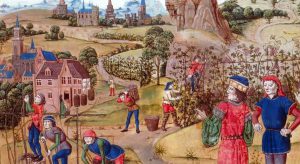
Medieval painting depicting life in a feudal manor
One of the main points of the Domesday survey was to find out the value of the land so that the king knew the value of the estates donated to his men. Such a vast project had to be highly organized and rely on local administrative units that had already developed in Britain. The image that emerges from Domesday is that of a firmly established possession system.
From the Domesday Book we learn that in 1086 the Manor of Hunningham belonged to William Fitz Corbucin, whose tenants were Osmund and Chetel.

Domesday book of 1086: Hunningham
Lords of the Manor of Hunningham 1086-2020
1086 William Fitz Corbucin
– Robert Corbucin
1161 Geoffrey Corbucin
1166 Peter Corbucin of Studley
1200 son Peter Corbucin, enfeoffed William de Cantilupe
– Richard Corbucin, died 1227
1227 son Geoffrey Corbucin
– brother Richard Corbucin
1284 John de Hastings, Lord Abergavenny
1325 John de Hastings
1334 William son of Sir William Trussell
1353 Isabell wife of Walter son of Hugh de Cokesey
– Sir Hugh de Cokesey, dsp 1445
1445 widow Alice de Cokesey
1460 sister Joyce Beauchamp
1473 son Sir John Grevill
1480 son Sir Thomas Cokesey
1500 bought by John Underhill
– son Thomas Underhill
– son Edward Underhill
1545 bought by Richard Newport
1565 John Newport
1566 William, later called Sir William Hatton
1596 Frances and husband Sir Robert Rich
1611 bought by Thomas Gibbes
– John Woodward
1614 Timothy Wagstaff
1614 Hannibal Horsey
1622 son James Horsey
1630 daughter Dorothy, wife of George Fane
1653 bought by George Fane
– Sir Henry Fane of Bassledon, Berks
1692 bought by Thomas and George Watson
1695 bought by Thomas Leigh, 2nd Baron Leigh
1710 son Edward Leigh, 3rd Baron Leigh
1738 son Thomas Leigh, 4th Baron Leigh
1749 son Edward Leigh, 5th Baron Leigh
1786 sisters, including Hon Mary Leigh
1806 Rev Thomas Leigh
1813 James Henry Leigh of Adelstrop
– son Chandos Leigh 1st Baron Leigh, died 1850
1850 William Henry Leigh, 2nd Baron Leigh
1905 Francis Dudley Leigh, 3rd Baron Leigh
1938 nephew Rupert William Leigh, 4th Baron Leigh
1979 John Piers Leigh, 5th Baron Leigh
1989 Roy Chew, Hunningham
2020 Dr Luca Lombardi, Bari, Italy
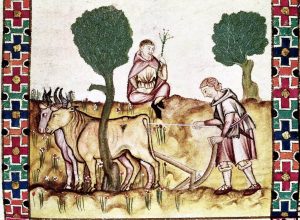
A farmer who teaches his son to plow a field in a manor (medieval parchment)
William Fitz Corbucin was one of the most important supporters of William the Conqueror in Warwickshire, he held several manors in the county, of which he was probably the sheriff.
After William Fitz Corbucin, Lord of the Manor of Hunningham was Robertin Corbucin, who was succeeded by Geoffrey Corbucin who was Lord of the Manor in 1161. Thus the lordship of the Manor remained in the possession of the Corbucin for about a century.
In 1284 the Lord of Hunningham was John de Hastings, 1st Baron Hastings, feudal Lord of Abergavenny. John de Hastings was an English peer and soldier. He was one of the Competitors for the Crown of Scotland in 1290-92 in the Great Cause. He was born in 1262 at Allesley, near Coventry in Warwickshire.
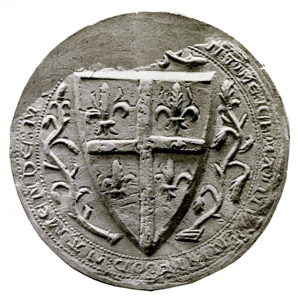
Seal of John Hastings
In 1273 he became the 13th Lord of Abergavenny upon the death of his childless uncle Sir George de Cantilupe, thus acquiring the vast lands of Abergavenny, including the Castle. Abergavenny Castle was built by the Normans to dominate the River Usk and its valley and thus protect themselves from raids into the lowland areas to the south and east. The structure, now in ruins, was imposing: it had a stone keep, towers, cellars, kitchens, a large hall, a porter’s lodge, a chapel and a formidable curtain wall dating back to the 12th century.
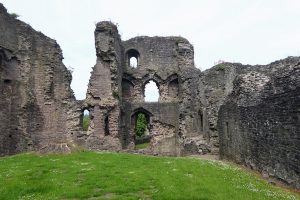
Interior of the surviving city wall and four story tower, looking west from within the grounds of Abergavenny Castle
Two towers of the Castle, one circular and one polygonal, were built between 1295 and 1314 by John Hastings. He also inherited many Cantilupe estates including Aston Cantlow in Warwickshire, one of that family’s seats. He fought from the 1290s in the Scottish, Irish and French wars of King Edward I and held the offices of Seneschal of Gascony and Lieutenant of Aquitaine simultaneously.
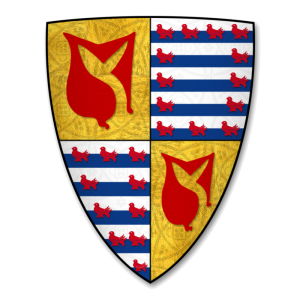
Coat of arms of Barons Hastings
In 1290 he had unsuccessfully contested the crown of the Kingdom of Scotland as grandson of Ada, third daughter of David of Scotland, Earl of Huntingdon, who was a grandson of King David I of Scotland. Also in 1290 he was summoned to the English Parliament as Lord Hastings, which created him a peer. In February 1300-1 he had licence to crenellate his manor and town of Fillongley in Warwickshire. He signed and sealed the Barons’ Letter of 1301 to Pope Boniface VIII, protesting against papal interference in Scottish affairs.
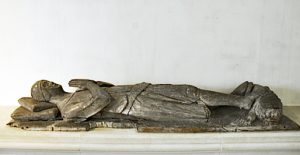
Effigy of John Hastings
In 1325 John de Hastings was succeeded by his son John de Hastings, who became Lord of the Manor of Hunningham. He served in the First War of Scottish Independence under King Edward II and was also Governor of Kenilworth Castle.
In 1334 Lord of the Manor of Hunningham was William Trussell, son of Sir William Trussell, an English politician and leading rebel in Queen Isabella and Roger Mortimer, 1st Earl of March’s rebellion against Edward II.
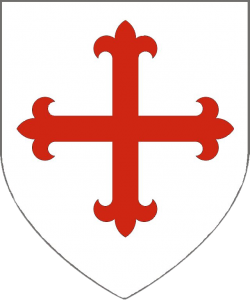
Coat of arms of Sir William Trussell
In 1353 the lordship of the Manor of Hunningham was held by Isabel, wife of Walter de Cokesey. Their son Sir Hugh de Cokesey died in 1445, so the lordship passed to his widow. When this died in 1460, the lordship of the Manor of Hunningham was inherited by his sister, Joyce Beauchamp, who died in 1473. Joyce Beauchamp was succeeded by his son Sir John Grevill.
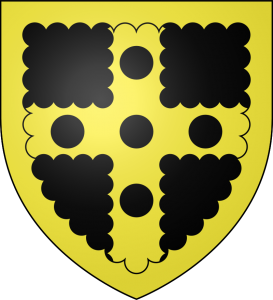
Coat of arms of Sir John Greville
Sir John Grevill was an English nobleman of the Greville family. His father John Greville (died 1444) served as a Member of Parliament in seven English parliaments. Sir John died in 1480 and was succeeded by his son Thomas, who changed his name to Cokesey, and became Sir Thomas Cokesey.
[Continue]
